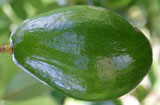Laurel Wilt
Laurel wilt is a fungal disease that infects trees in the laurel family (Lauraceae). The disease is spread by the non-native redbay ambrosia beetle, a small wood-boring insect.
Affected plants of concern include avocado (Persea americana), redbay (P. borbonia), swamp bay (P. palustris), and sassafras (Sassafras albidum). Some avocado species may be more susceptible than others.
Foliage and young stems on infected trees will wilt and become discolored, mainly in the crown. Sapwood below the bark will have black to brown discoloration. Trunks will often have sawdust around beetle entrance holes. (Some of the sawdust may look like toothpicks protruding out of the trunk.)
Laurel wilt was detected in the US in 2002 and in Florida in 2005. By 2009, the disease was present in many northeastern and Atlantic coast counties in Florida. In 2010 and 2011, the disease “jumped” several counties to Miami-Dade and Bay counties. This pattern of spread indicates that laurel wilt most likely spread to Miami-Dade and Bay through wood products infested with red ambrosia beetles.
For more information on laurel wilt and management strategies, contact your local Extension agent and read the following publication:

Related Sites
- UF/IFAS Publications
- Homeowner Detection of and Recommendations for Mitigating Redbay Ambrosia Beetle – Laurel Wilt Disease on Redbay and Avocado Trees in the Home Landscape
- Estimates of the Replacement Costs of Commercial and Backyard Avocado Trees in South Florida
- UF/IFAS Sites
Redbay Ambrosia Beetle/Laurel Wilt - Other Sites & Publications
- Laurel Wilt—USDA Forest Service
- Laurel Wilt Distribution Map—USDA Forest Service
- Laurel Wilt FAQs—USDA Forest Service
- Laurel Wilt—FDACS

